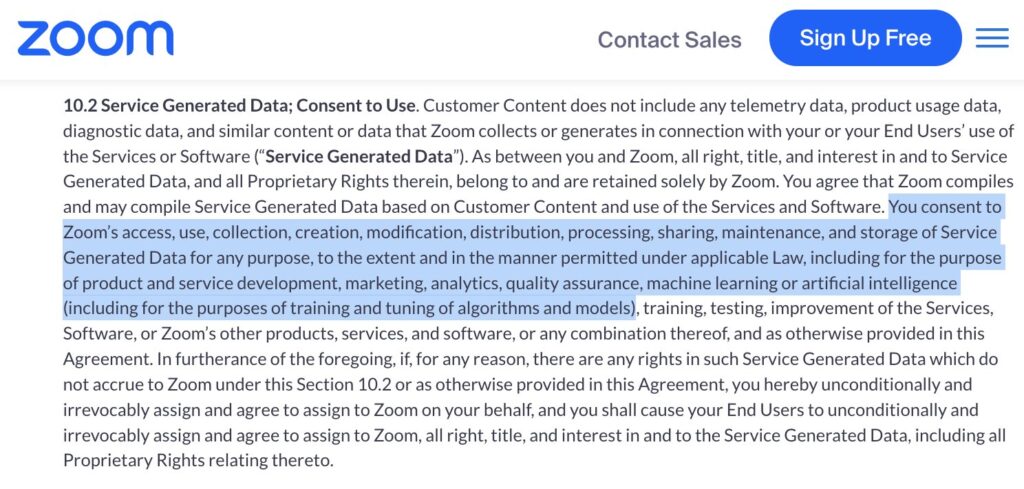Zoom’s Updated Terms of Service:
A Broad Overview
Zoom Video Communications recently updated its terms of service, amplifying its rights to collect, use, modify, and distribute user data, including its application for machine learning and AI. The noticeable lack of an opt-out option has ignited considerable concerns about privacy and consent.
Deciphering the Fine Print in Zoom’s Updated Terms of Service
The new terms of service grant Zoom a “perpetual, worldwide, non-exclusive, royalty-free, sublicensable, and transferable license” to execute a wide range of actions on user data. Although Zoom defends these provisions as crucial for improving its services, the broad language can imply data usage for any related purposes.

The Shared Responsibility Model Analogy: Understanding User and Provider Accountability
Drawing an analogy to the Shared Responsibility Model (SRM) used in cloud computing, both the service providers and the users have distinct roles in maintaining data security.
In the context of Zoom’s updated terms, the company should strive to strike a balance between its need to enhance services and the user’s privacy and consent. The absence of an opt-out option and the extensive rights Zoom now holds may seem to push the boundaries of what is typically considered acceptable in data privacy. Meanwhile, the users bear the onus of understanding what they’re agreeing to when using a platform.
This understanding is crucial, as without it, they might unwittingly consent to conditions that compromise their data privacy.
Zoom’s Response to Rising Privacy Concerns
In response to the privacy concerns stirred by Zoom’s updated terms, COO Aparna Bawa clarified that users would decide whether to enable AI features and share their content with Zoom. However, her response does not directly address the broader implications of the updated terms of service.
Lessons from Zoom’s Updated Terms:
Shared Responsibility in Identity and Access Management in Focus
Zoom’s recent changes and the ensuing discussion provide a practical case study illustrating the Shared Responsibility Model (SRM) within the field of Identity and Access Management (IAM).
In a Software as a Service (SaaS) context such as Zoom, the SRM delineates the responsibilities between the Cloud Service Provider (CSP) and the customer.
The CSP secures the cloud’s core elements like the infrastructure, hardware, and physical facilities.
Meanwhile, the customer’s role is to protect their data, manage their configurations, and implement secure IAM protocols within the cloud-based applications they use.
This arrangement underscores the need for users to understand their responsibilities towards data security, parallel to the need for users to comprehend the terms of service when using platforms like Zoom.
The comprehension is key to safeguarding user privacy and fostering a mutual understanding between users and service providers, leading to safer digital environments.
The Future of Privacy: Implications of Zoom’s Updated Terms of Service
Zoom’s updated terms of service signal that discussions around digital privacy are still very much alive. As users, the onus is on us to continually educate ourselves about our rights and responsibilities when using digital platforms.
Final Thoughts: Navigating Privacy in the Era of AI
Zoom’s recent update to their terms of service is a strong reminder of the ongoing privacy issues we face in the era of Big Data.
Companies, in their pursuit of providing better services, may sometimes appear to overlook the importance of user consent and privacy. As users, we must ensure we are educated about our rights and the implications of the terms of service we agree to. Equally, companies must commit to transparency and respect for user privacy.
In this way, we can collaboratively work towards a digital landscape where advancements like AI and machine learning are harnessed responsibly, and user privacy is not compromised.
However, it is also essential to acknowledge our role as users in understanding and agreeing to these terms.
Much like the Shared Responsibility Model in cloud computing and IAM, maintaining digital privacy requires an active effort from all parties involved.
This model advocates for a balance of mutual understanding and respect between all parties, fostering safer, privacy-centric digital environments.
